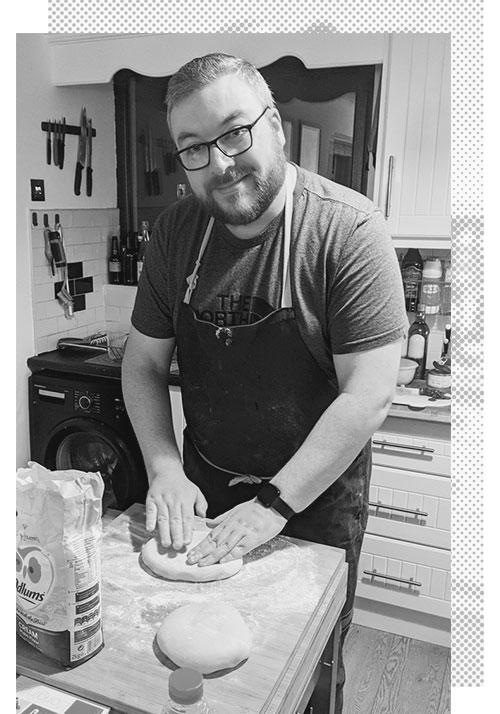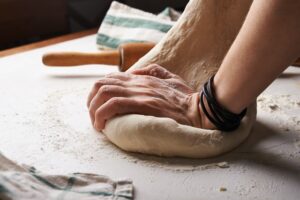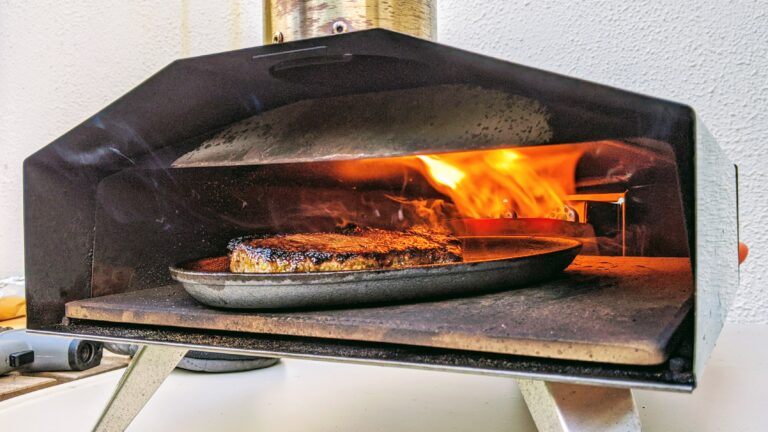Cooking with Kev
Making the Most of Your Pizza Oven
Whenever I post pictures of my pizzas on social media, I usually get a couple of people reaching out with similar questions, “How can I make pizza like that at home?” “What kind of oven is that?” “How do you make your dough?” etc.
I wanted to put together a resource that answers some of the common questions I get and help you start to make amazing pizzas at home in an outdoor oven. I’ve also collected some guides, videos and recipes for people who are already making good pizzas and want to make them great!
Videos
Recipes
Top Tips
What else can I cook?
Which oven?
Fuel
Can I make good pizza in a normal oven?

Videos
The Overview
Good overview the whole pizza making process. Nice place to start for a basic understanding of what lies ahead.
The Process
A more detailed look at the process, explores a lot of the theory behind each step.
The Pie
How to shape the dough (the video will start the point I think is important here, but the whole video is worth watching!
Same Day Dough
Here is a video for a ‘same day’ dough that I have used with success 6 hours before a bake
BA's Perfect Pizza
Here is a 40 minute video that is part of a 3 hour series on making the perfect pizza by Bon Appetit, the whole series is well worth a look but this episode focuses on dough.
That's a Paddlin'
10 tips on pizza launch technique. Don’t let your pie get too friendly with that paddle.
Wood Fired Pizza
This guy has dozens of episodes using his full dome wood fired oven and is living the life.
Time to Launch
10 tips on pizza launch technique. Don’t let your pie get too friendly with that paddle.
Recipes
Same Day Neopolitan Dough
Ingredients
To make 3x 220g 10 inch bases you will need:
- 400g 00 caputo pizza flour (for best results in an outdoor oven, use 00 flour, but normal plain flour will also work)
- 250g water (this is 62.5% hydration)
- 12g table salt
- 2.5g dry active yeast
To make adjustments for number of pizzas or size/weight or hydration use this app.

Method
- Mix the dry ingredients in a stand mixer with a spoon, then add the water and using a dough hook on low speed, mix until combined, then set to medium speed for 8 to 10 mins until the dough has become smooth and fully formed (to mix without a stand mixer, follow this video).
- Remove the dough hook and put clingfilm over the top of the bowl, leave at room temp for 6 hours. The dough will more than double in size in this time.
- Remove the dough from the bowl and divide into three equal balls.
- Leave the balls on a floured surface and cover with a tall bowl or oven dish, leaving room so as the balls do not expand and touch each other or the sides/top of the covering. I have seen people recommend that they use a damp towel to cover the balls so they do not dry out, I have not used this.
- Then leave the balls at room temp for a further 3 hours.
This recipe means that if you make the dough at 9a.m, ball them at 3-4, you can be making pizza by 7-8 pm.
Overnight Neopolitan Dough
Ingredients
To make 3x 220g 10 inch bases you will need:
- 400g 00 caputo pizza flour (for best results in an outdoor oven, use 00 flour, but normal plain flour will also work)
- 250g water (this is 62.5% hydration)
- 12g table salt
- 2.5g dry active yeast
To make adjustments for number of pizzas or size/weight or hydration use this app.

Method
- Combine dry ingredients in a stand mixer bowl, then add water and run on slow/medium speed for ten mins. This will form a smooth, slightly sticky dough (to mix without a stand mixer, follow this video)
- Once all ingredients are mixed, cover the bowl with plastic wrap and rest at room temp for 6 to 8 hours until it doubles in size, then cut and shape into 4 balls of around 210g.
- Store covered for 12 to 24 hours in the fridge in a lightly oiled container.
- Remove from the fridge 2 to 3 hours before cooking to allow a final prove at room temperature.
To make adjustments for number of pizzas or size/weight or hydration use this app (higher % hydration means puffier, lighter and chewier crust, but stickier and harder to handle). 60% hydration is plenty wet in my opinion, and easy to handle.
This is a screenshot for my settings when I make two pizzas and prove for 8 hours before being in the fridge overnight: adjustments can be made to all the elements (RT is room temp, CT is cold temp/fridge).
Top Tips
Tips: Work The Dough
- For Neopolitan pizza, you want to keep as much air in the dough as possible when shaping it, so no rollers. For New York style or Thin and Crispy pizzas, you can use a roller.
- Gently remove the dough ball from its container (if left overnight in fridge, do it while still cold to avoid sticking and leave it to rest on a floured surface for two or three hours, but it can be removed from the container and shaped just before cooking if it is not sticky).
- There is no need to use the good 00 flour when shaping the dough before cooking, but you will need flour of some sort. Dip the bottom of the dough ball in flour, then dust the top and cover your hands with flour and flour the surface where you will shape the pizza. Using the underside of your stretched fingers, flatten the centre of the dough, pushing the air out to the edge. Leave a half inch rim of air all around the edge.
- If the dough is dry enough to handle, pick it up and turn it like a steering wheel while holding inside the rim, allowing gravity to stretch the dough. Check out this video if you need help to visualise.
- I recommend shaping the base, then putting it on a peel before adding sauce/toppings, then launching it from the same peel into the oven rather than shaping it on a table, then adding toppings and trying to pick it up with the peel and launching it.
- Put flour/cornflour/semolina on the peel before adding the base but not too much (too much flour will burn in the oven) to make sure that it launches into the oven successfully (and give it a little jiggle once in a while while adding toppings to stop it sticking to the peel before launch).
- I recommend a wooden peel for building/launching the pizza and then a metal peel for turning the pizza in the oven and removing from the oven. (a metal peel will get hot between pizzas and make the next pizza stick to it, pizzas also release easier from a wooden peel. Wooden peels are fine for turning the pizza but metal ones are thinner and less likely to damage the half cooked pizza.)
Tips: Toppings
- The less time between shaping the base and getting it in the oven, the better, as soon as you add sauce, the base starts to become wet and more likely to tear.
- With proper gas/wood ovens, cooking time is less than a minute for neapolitan style pizzas, so the fewer toppings, the better. It will need less sauce than you think, less cheese and fewer toppings. More sauce/cheese/toppings can cause the pizza to be wet/floppy and stop it crisping.
- I use fresh mozzarella but it can be wet, so I only use a little. With low moisture/shredded mozzarella it will not melt as well, but it will be dryer.
- If adding onions or mushroom or pineapple or other wet toppings, it is a good idea to pre-cook these ingredients (in a pan) to remove some of the moisture.
- Here’s a video with some good toppings/combos for inspiration.
- I love a drizzle of honey on my pizza just before I cut it, it might sound weird, but do try it!
Tips: Sauce
- I used to spend an hour making a cooked New York style sauce following the recipe in this video. It is a good sauce, but more suited to a longer bake time (thin and crispy/New York Style/Bar style pizzas)
- For a Neopolitan style pizza, I just get a can of peeled plum tomatoes, and blitz it into a pulp (or crush them with your hands), add a little dried oregano and basil and garlic powder and salt/pepper and that’s it, it takes five minutes.
- I recently started using the Mutti Pizza sauce. It comes tinned from most supermarkets and is very good. I like its consistency and it comes in big tins as well as smaller tins. It is really handy if you have no time to spend making a sauce or want to make pizza while camping or are transporting ingredients.
- Only a couple of tablespoons of sauce or less per pizza will be needed for a 10 inch pizza. Use the back of a spoon to spread it evenly.
Tips: Cooking Outdoors
- I use a laser thermometer to check the temp of the oven floor, but this is not essential, following your oven’s instructions for preheating (on max for 20-30 mins) should preheat your pizza stone enough for baking. I like to aim for 450 C/850 F on the centre of the stone, even though some ovens can reach 550C/1000F, I have had pizzas literally burst into flames and turn black within seconds or cook the base before the cheese has even melted. Hotter is not always better. Ideally it should not be under 400C or over 500C.
- When baking multiple pizzas, once you cook one pizza, allow five to ten mins for the stone to come up to temperature again before attempting to bake another pizza.
- Ideally, you want to launch the pizza into the centre of the oven in one, confident throwing motion, you don’t want part of the base touching the stone and then jiggling the pizza forward or it will fold or tear.
- I recommend making an extra dough ball than you think you will need, just in case one messes up (I make the extra one with whatever leftover toppings if not needed and reheat it in the home oven in a cast iron pan for lunch the next day).
- My current method is to launch the pizza into the centre of the oven, wait 20 seconds, rotate it 120 degrees (by sliding a metal peel under it, taking it out and using tongs or my fingers to rotate it), then another 20 seconds, rotate, then a final 20 seconds. But most guides will show a 30 second wait, then a 180 degree turn and then another 30 seconds. It will take you a few tries to get to know your oven.
What Else Can I Cook in My Oven?
Steak
A great intro to cooking steak in a pizza oven on a cast iron pan.
I use this cheap cast iron pan from Amazon.
Regular cast iron pans can be used but the high sides on these pans can slow the cooking, I also worry that the high high heat will strip the seasoning on ‘good pans’.
The pan will get ripping hot very quickly in the pizza oven and will sear steak far quicker than on a grill or in a normally heated cast iron. I recommend keeping the flame on medium-low once the pan has come up to temp and put the steak close to the mouth of the oven. Otherwise it will literally burst into flames.

There is no need to put oil/fat in the pan before adding the steak, I recommend putting a thin layer of olive oil or peanut oil on the steak itself with seasoning of your choice and then searing for 30 seconds on each side in the oven, then check the temp and finish in the pan (outside the oven). Use a temp probe to ensure the steak is cooked to your liking. Since the pan will be so hot, it may seem done, but still be blue/raw inside. Be sure to take the steak off the pan and rest away from the pan/oven, otherwise it will overcook.
Chicken Wings
While it is possible to make wings from scratch (raw to cooked) in a pizza oven as in the above video, I think cooking them low and slow in a home oven or slow cooker and then finishing on the Pizza oven and cast iron before saucing while resting will create a more tender result.
Lamb Chops
Basic steps are the same as the steak above. I recommend sous vide with rosemary and garlic and finishing on the oven, or marinating overnight on rosemary and garlic and cooking from scratch in the pizza oven on cast iron.
What Oven Should I Get?
The two most common brands you will see recommended are Ooni (formerly called Uuni) and Roccbox. There has been a huge explosion in interest in outdoor pizza ovens in the last 5 years and the technology has improved quickly in that time. This wonderful video from Kenji, even though it is from 2017 is already out of date but it gives a great overview of the most popular types and brands.
Here is a newer video where he compares the two current most popular ovens from Ooni and Roccbox.
The Ooni and Roccbox are the most popular for a reason, they simulate a traditional wood fired pizza dome quite well, are able to get up to 1000F and they are easy to set up, easy to use and are portable, they also have big online communities on Facebook groups and subreddits where you can find support.
I have an Ooni 3 wood pellet oven but also have a gas conversion kit for it and I now almost always use gas, it is much easier. They no longer make the Ooni 3, but if I was buying an oven now, I would get the Ooni Koda 16. It is expensive and hard to justify that price unless I was using it all the time, the Koda 12 is a smaller version and might be a better choice for your first oven. Both of these are gas-only and cannot be used with other fuels.
The cheapest Ooni they make right now is the Fyra, it uses wood pellets and seems like a really good set-up and could be a good beginner option if you want to go with wood pellets over gas. The newest Ooni is the Karu and can use wood chunks, coal or pellets and you can even add a gas conversion kit to it, it seems to be a very flexible option, here is a video comparing the Koda and the Karu.
Roccbox have one main product and I have seen solid reviews for it, the price is on the higher end of the Ooni ones and they have an absolute monster of a dome coming out next year for crazy prices.
The third option would be whatever is for sale in your local hardware/garden centre, this may even be an own brand or Chinese knock off. Pizza ovens are not rocket science, it is a metal box with a pizza stone in it with a fire at the back and it’s up to you to decide how often you will use it and what budget you want to go for. I would definitely consider a box/dome model over something that adds on to a BBQ or uses a heat source from below, the physics of these ovens would make neapolitan pizzas impossible but I am sure the results would be fine for use once or twice a year.
The secret 4th option is electric, which is handy but very expensive. This oven is a professional level oven that will last for years and is easy to use, but costs the same as a second hand car once you consider delivery.

Fuel
The best advice might be to decide on a fuel type and then get whatever one is available within your budget, there are long shipping times at the moment with Brexit and high demand due to Covid lockdowns. With that in mind, here is a breakdown of the fuel types and their pros/cons:
Gas
- Pros: Easy to use, no need to worry about topping it up while cooking, just turn it on and it is easy to adjust. It does not need to be babysat while heating up.
- Cons: You need to make sure you don’t run out of fuel and it can be difficult to gauge how full your gas tank is. Butane gas does not perform well in freezing temps, but how often would that be needed? It probably works out more expensive than wood pellets, but not by much a few cents per minute. While it is portable in theory, you would not want to bring a butane gas tank camping or to the beach. The absolute highest temp on gas is not as high as wood or coal and can take longer to get up to temp.
Wood Chunks / Coal
- Pros: Feels like a BBQ. Holds heat really well, once they come up to temp, you can add fuel once in a while and control the temp. Can get seriously hot.
- Cons: Hard to store, hard to light, hard to keep at a specific temp. Expensive compared to gas or wood pellets.
Wood Chips
- Pros: I have seen some people say that it gives a smoky flavour, I think this is a bit spurious as the pizza cooks in under 60 seconds and is not enough time to have an impact on flavour. The wood pellets are very portable and you can bring a ziplock bag of pellets on a camping trip which would be enough for a couple of pizzas. The wood pellets get very very hot very quickly. They are super cheap, you can buy 10kg online for half the price of a bottle of gas, Ooni sell their own brand ones but they are overpriced. There is no difference between them and others for sale online.
- Cons: I have seen some people say that it gives a smoky flavour, I think this is a bit spurious as the pizza cooks in under 60 seconds and is not enough time to have an impact on flavour. The wood pellets are very portable and you can bring a ziplock bag of pellets on a camping trip which would be enough for a couple of pizzas. The wood pellets get very very hot very quickly. They are super cheap, you can buy 10kg online for half the price of a bottle of gas, Ooni sell their own brand ones but they are overpriced. There is no difference between them and others for sale online.
Electric
- Pros: Super easy to use, just hit a button.
- Cons: Crazy expensive.
Can I Make Good Pizza in a 'Normal' Oven?
The answer is…”Sort of…”
While the nature of neapolitan pizza means that it needs a 500c/900f oven to be able to get that fluffy/chewy/crispy/moist texture on the dough and the freshness of the toppings, you can still make other kinds of great pizza in a ‘normal’ home oven,especially if you have a pizza stone, a pizza steel or even a large cast iron pan.
Even if you don’t have those things, you can still make a way better than average pizza which will be better than most of the other options available to you (especially in lockdown). Check out this video for how to cook a pizza from scratch using the bottom of a normal home oven pan.
There has been a lot of science put into answering the question as to whether you can cook a ‘proper’ pizza in a home oven, two of the best videos on the topic are this one from Bon Appetit titled Every way to make a pizza. They test all the possible ways to cook it in a home oven and even some specific tools and machines (like the Ooni and the Breville home oven) what they found was:
- Using an Oven steel or pizza stone will give you a big advantage.
- Using an Outdoor oven like an Ooni is closest to ‘restaurant quality’.
If I am making a pizza without an outdoor oven, the method I will use will be the Cast Iron Pan method. You can even use one of the above dough recipes to make a great dough, and then put it in a large cast iron pan in a home oven and get great results. It won’t be a Neapolitan pizza, but in some ways it will be better. The wonderful (and now cancelled) Bon Appetit have a full video on this here.
There is a pizza that is more popular in American than here called a ‘pan pizza’ and that is a great option if you’re looking to make a tasty pizza in a cast iron pan, it uses oil in the dough to give a wonderful crispiness. Here is a great video that shows the process start to finish.
Made by Mel for Kev. Thanks for all the pizza ❤️